FINAL MAJOR PROJECT
- Izabelle Tooze
RESEARCH PLAN
INITIAL CONCEPT
When coming up with my initial concept, my first through was to try and translate my GDD from the conceptualise project into a top-down 2D game in construct. I wanted to do this as I really liked my story from that project and it would save the work of creating a new concept. I then created a prototype in construct (in next section) to see how this could work. Although I was happy with this prototype I realised that re-using a story limited my opportunities for research and it would be better if I created a whole new concept. So I took the prototype and created a new concept from that, separate from the previous project.

Here is a document where I brainstormed what my new concept could be, essentially writing down everything that came to mind. As you can see here this is where I came up with the idea for rhythm game style combat, and how it would work in game. I decided to have it so each missed note takes away player health which I translated into construct. I also talked a little about a potential story, with the player meeting another human in this world with the same abilities. I also decided that the game should be in a pixel art style and from a top down perspective like the prototype.
CONSTRUCT PROTOTYPE
This is the log of the first construct prototype that I made to test how different mechanics would work. This was made with the idea of creating my Conceptualise GDD as a 2D game, so it contains the characters from that as placeholders.
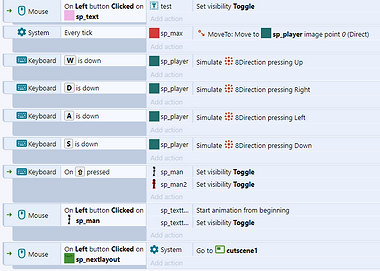

Here is the code and a screenshot of how the overworld could work. I wanted a mechanic of clicking on different items to display text about them. I did this with the pink block, the text is initially invisible but can be toggled by the player clicking on the block. I also wanted the control to be WASD instead of the arrow keys as it felt more natural and it meant I could use other buttons for different actions. I had a bit of problem doing this as I originally put the command as "key pressed" instead of "key down" which meant that the player didn't move. I figured this out by looking at a tutorial and now it works fine. This is obviously in a top down style which I have never made before, but it was simple to create. I made a few other simple mechanics like clicking buttons to get to different layouts just to make it easier for me to test different mechanics. I also made another block follow the player as I wanted the other main character from the GDD to follow the player but this was later scrapped as I made up the new concept.
PROTOTYPE 1
This is the code and a screenshot of the cutscene mechanic. I had trouble trying to figure out how this works so a classmate helped me and showed me this method of doing it. Basically there is a global variable called cutsceneNumber that controls what scene of the cutscene the player is on. When enter is pressed it adds one to this variable which moves it onto the next scene. For the scenes themselves, there are the characters and text which are initially invisible. When the variable matches the scene it makes the correct character and text visible and then invisible again when the next scene is played. As for the text, I created animations in construct where each letter is typed out individually. I did this to add more style and character to the text, and I will probably be using this style in the final game. In the cutscene there is a multiple choice section where the player can choose between two different dialogue options with different responses from the other character. I did this in essentially the same way as before, clicking either button adds one to the variable and plays the scene.
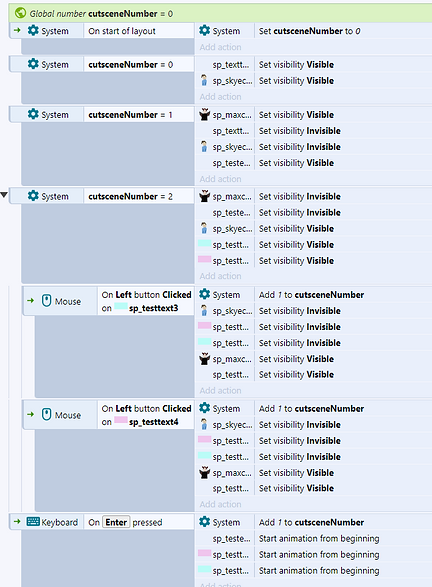
Here is a video of the cutscene and a link to this prototype. I originally drew the characters in this simple style out of ease but I like the way it looks and may use it as inspiration in the future. I also like the sort of awkward dialogue as I think it is unique and would add some humour to the game. So I may also use this is as inspiration for the final game.
GAME FEEL
Today I did some research on game feel by watching various YouTube videos, all of which are linked here. I wanted to look into game feel so my game doesn't feel empty or lifeless for the player. Below are all the different things I learnt that improve the game feel or add to the 'juice'
-
Tight responsive controls - you do not want the controls to feel unfair or not fun to control.
-
Animations - lots of different animations add life to the character and emphasize movement
-
Particle effects - dust particles when characters are moving for example, makes the character feel like they're really there
-
Screen shake - emphasises action packed sections.
-
Feedback to actions - Making sure the player knows that their actions are being counted, for example a health bar or changing sprites when an enemy takes damage
-
Making simple mechanics more interesting by giving the player decisions to make - for example different types of attack that have advantages and disadvantages over others. Keeps game from being boring.
-
Interesting colour schemes - makes the game more visually appealing and fun to look at
-
Pacing - Make sure the game is paced well, not being too slow and boring
-
Directional effects - have particle effects move in the direction they are created to give more player feedback
-
Camera Movement - Having the character move fluidly around the character to give the game more life
-
Adding effects and animations to environment - For example the grass blowing in the wind, leaves falling, silhouettes of swinging plants, birds flying away when you come close. Makes the world feel more alive.
-
Sound effects - Add lots of different sound effects like walking on different surfaces to give more feedback about where the player is in the world.
-
Light source attached to the player - gives more life and makes character pop more
-
Rays of light - more alive world.
I will definitely take all these different elements of game feel that I have learnt into consideration when making my game as they are very easy changes that can make my game feel so much better. I think next I will want to look into game feel for specifically rhythm games by playing them and figuring out what makes them so addictive and feel good to play.
SIMILAR EXISTING PRODUCTS - UNDERTALE
Undertale is a 2D top-down indie RPG released in 2015. It has become extremely popular for its memorable cast of characters and unique story and gameplay mechanics. You play as Frisk, a human who has fallen into a world of monsters. You adventure through the world meeting different characters and fighting enemies to progress. A core mechanic of the game is being able to choose the direction of the story by your actions to the enemies. You can choose to spare all enemies which causes a pacifist playthrough, kill all enemies which causes a genocide playthrough, and to do a mix of both which causes a neutral playthrough. Each of these options has its own unique bosses and story.
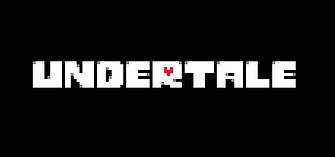

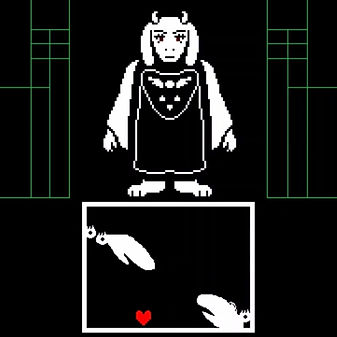
For this I created a research plan on a jam board to figure out what game I wanted to look into and what aspects of that game inspired my own. Below this I looked into each of these aspects in detail.
As for the combat, the player controls the small red heart which can be seen in this picture, and has to avoid the white attacks that the enemy sends out. The heart is controlled with arrow keys, but the physics depends on what enemy you are fighting. Some enemies make the heart have gravity and other mechanics. After avoiding these attacks, the player can choose to damage the enemy or try and spare it, which decides the course of the story.
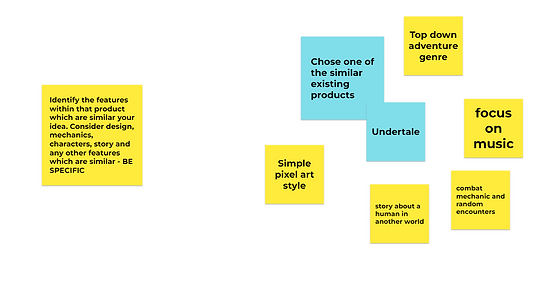
TOP DOWN STYLE

This game is in a 2D top-down perspective, the same as my game will be. This is a big inspiration for how the world will look and function, I will take inspiration from the pixel art from the different sections of this world to get an idea of how my own will look. I am going to play the game myself to get an idea of how this style of game should feel and how the physics should work, and then translate that into construct
ART STYLE
Here are some pictures of the sprites from Undertale, the simpler ones from the overworld and the black and white ones from the combat. This goes for a similar technique as my game will, simpler sprites in the world and more detailed ones in cutscenes or combat. As I do not have many skills in art or pixel art, this style will be easier for me and give me more time to make the actual game, as that is the main focus of the FMP. This style will inspire my game as I will try and create my sprites in a similar style to match the world and to not overcomplicate development.




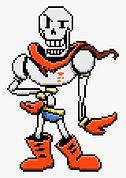

COMBAT

Here is a video of how the combat works in this game, this battle being the final and most difficult boss. Obviously it is a lot different to how my game's combat will work, being a rhythm game, but I will still take some elements from this as inspiration. For example, the way the combat is laid out. The enemy is standing in front of you, with the interactive part being below it and the players health at the bottom. Also the way battles are initiated is an inspiration, random encounters in an RPG style with progressively more difficult bosses throughout the game with their own unique mechanics.
MUSIC
One of the things Undertale is most known for is it excellent music, and it is a big inspiration for me as my game has a large focus on music due to the combat. Here I've selected a few of my favourite tracks in the game and talked about what feel they give off and how this could relate to my game
These three tracks in my opinion give off the feeling of huge, important battles and lots of action. All of these songs are quite heavy, specifically 'Meglovania' and 'Death by Glamour'. 'Battle Against a True Hero' is the most 'final boss' feeling song, with the piano at the start making it sound quite sad and reflective of the players journey so far. As for my game, I would use these tracks as inspiration when creating the music for an important battle against a strong opponent or a character very significant to the story. I also think these kinds of songs would work well in my rhythm game format as they have memorable tunes that repeat and allow the player to learn the song.
These 3 tracks are very different but I think they perfectly convey the atmosphere of where they play. 'Can You Really Call this a Hotel' sounds happy and bubbly, as it plays in the bright and happy hotel. 'Amalgam' plays when fighting enemies in the spooky secret area, and gives of an unsettling feeling. The synth almost sounding cold and lifeless just like these enemies. 'Fallen down' plays when the player is rescued by Toriel, a character which looks over the player. The track manages to sound safe and warm with only simple instruments. These tracks are inspiring for my game not so much for the combat, but for creating atmosphere in certain areas and communicating to the player what the atmosphere is.
Once again these songs are very different but this time portray the personality and emotions surrounding a character. 'Ghost Fight' plays when encountering the ghost boss and has a spooky yet upbeat and jazzy sound, very reminiscent of the personality of this character, being a ghost that is not at all scary. 'Bonetrousle' plays when meeting the character of Papayrus, a dumb and loveable skeleton. The simplistic beat and silly melody of this track show this well. And finally 'His theme' plays when finishing one of the toughest battles, the enemy giving up his hatred and revealing himself as just a child. This track shows the innocence of this character and is very sad with the piano, bringing more emotion to this moment. I will use these as inspiration when creating music for specific characters, as music can be a big help when establishing characters without being too explicit.
As the final part of this research I went home and played the game myself, the footage from this seen here. In the video you can see how walking around the overworld works, how random encounters work, and an example of a boss fight. You can also hear some of the music and get an idea of the humour of the game, with self-aware and witty dialogue for some of the characters. This humour is an inspiration for my game as I think is is unique and I would be able to write it well.
As for the gameplay mechanics, it has the movement be in separate screens that the player goes between, similar to the original Zelda games. My game will have the camera following the player instead of this. Playing the game also gave me an idea of how a top-down game should look and feel, with animations that make the character seem like they're really there and smaller details like the sprite being able to go halfway into the wall, making it look more realistic. I will be replicating both of these details in my game as it think they look professional and add to the game feel. The way the random encounters work is pretty standard, an enemy appearing every 20 steps or so. I will probably make it similar to this in my game so it doesn't get boring when exploring and so the player can encounter and learn ways to defeat different enemies. The way the dialogue works in this game will be different to mine, as in this game the text simply appears above the character when mine will have cutscenes to display most dialogue.
In conclusion, this research really helped me get inspiration for my game and gave me a strong idea of how games in this style should look and function. I will definitely be refencing this research throughout the project, probably when creating the music as that is the part of this game that has inspired me the most.
TARGET AUIDENCE RESERACH
Today I wanted to get a better idea of my target audience so I made a survey to get an idea of what types of games people enjoy, their opinion on rhythm games and their opinion on simple pixel art styles. I also created an audience persona sheet and looked at different types of fun.


Here is the first question of the survey, asking what kinds of genres people are interested in. I did this just to get an idea of how wide the demographic of my game could be. The results showed that RPG was the most popular genre, followed by action-adventure, puzzle and strategy games. This is good as my game has RPG elements and is an adventure game. I also found that rhythm games had no votes, maybe telling me that the rhythm game combat may only have a niche appeal. I think because it is only a mechanic of my game it wont take away from its appeal.

This question spoke about what type of rhythm game is the most appealing to a player. The most popular rhythm game is a tie with Guitar Hero and Beat Saber, with Dance Dance Revolution getting no votes and one person not knowing any of the games. I am glad that Guitar Hero got votes as that is the style of my rhythm combat. The one person not knowing further shows that maybe rhythm games are a bit of a niche concept and doesn't have wide appeal. I may have to explain how the rhythm combat works inside the game more clearly to account for this.
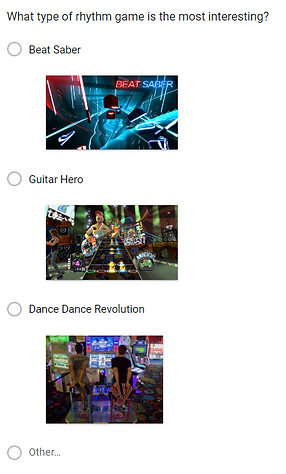

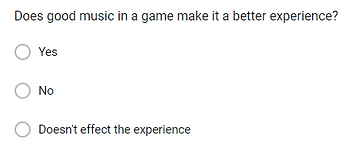
This question asks if music is important in a game. Unsurprisingly, most people said yes with one person saying it doesn't effect the experience. This is good as there is definitely an audience for games with a focus on music like mine.

This question asked if games with pixel art styles are visually appealing and what they would change about them. Everyone who has played these games found them appealing and wouldn't change them. One person said that they would add more colours to old Zelda games due to console limitations at the time. This is a good response as it shows that I can use
a pixel art style in my game and it still would be appealing visually


Similar to the last question, I asked if a pixel art style would put someone off playing a game. Most people said that it depend on the quality of the art. This shows me that I still have to put in effort to make the pixel art visually appealing despite how simple it is.
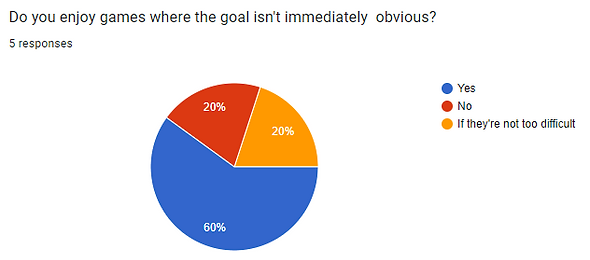

The last question asks if games where the goal isn't obvious are enjoyable. Personally I am not a fan of cryptic games where it is not obvious where to go next, but this question shows that there is a market for this style of game as it got 60% of the votes. I may include a bit of this in my game but not too much as I don't find it enjoyable.
Doing this research has helped me get an idea of the potential audience of my game and how much of a wide appeal its genre and art style has. It has given me confidence that my game has appeal to an audience and people would want to play it.
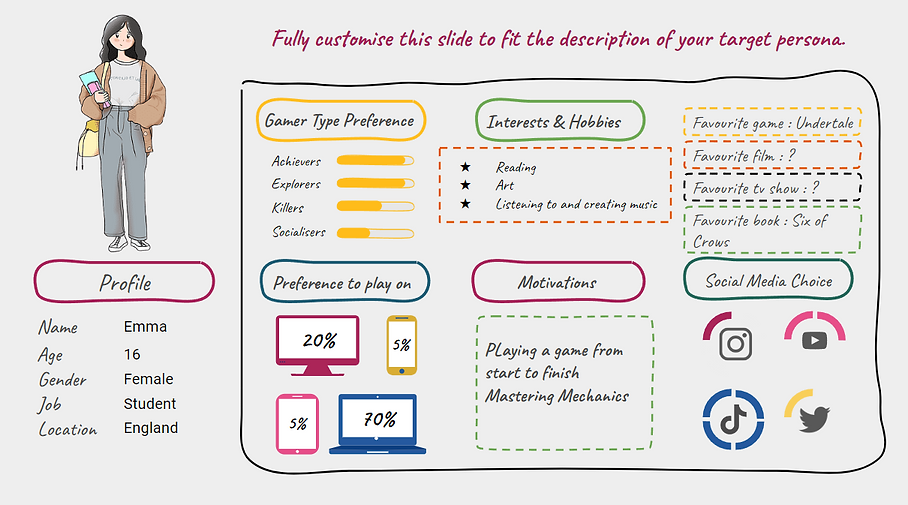
Here is an Audience Persona Sheet to get a better idea of what my target audience is. I will keep referring to this and my previous research to make sure the game still fits with this audience.

Next I looked at different types of fun with the 4 Keys 2 Fun model to get a better idea of what my audience would be. This model fits games into 4 different types of fun; hard fun, people fun, easy fun and serious fun. I think my game would fit into easy fun, where the player is allowed to explore the world and its features without much challenge. While some combat sections may be more difficult, for the most part my game is more focusing on exploring the world and its characters, with the combat as an enjoyable mechanic and not an obstacle. I want the player to be able to enjoy the music and visuals without being too distracted by the difficulty. I will however have to make sure the game isn't too easy to avoid boredom
SIMILAR EXISTING PRODUCTS -
THE ESCAPISTS
The Escapists is a top-down 2D game about escaping various prisons, using items that you can create or buy and trying to escape as fast as possible. While the gameplay is very different from my concept and not an inspiration, the top down gameplay, art style, music and dialogue are all inspirations.




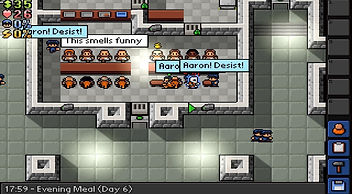

Here are some pictures of the character sprites and visual design of the game. As you can see, the art is very simple but works well with this type of game and doesn't take away from the experience, In an interview with the developer of this game he says about the art style:
"They’re only basic 8-bit style sprites, it’s just the way I’ve made games in the past. It’s just how I’ve always done it, keeping things simple."
"I mean, if you took The Escapists and made all the characters as real models, if it looked realistic, it’d change the whole flavour of the game. It wouldn’t be this retro cutesy Pokémon style game anymore."
This shows that the developer wanted to keep the art style simple, much like with my game and it tells me that a game doesn't have to be in a complicated art style for it to be enjoyable.
As for the art style itself, the world is just made up of simple blocks and 8-bit sprites. While my game probably wont be made of blocks, I will take inspiration from the sprite work and animation which I think are very effective.
ART STYLE
MUSIC

I really like some of the music in this game because of the atmosphere it makes - making the player feel a different way because
of the music. This track plays when it turns night-time, and I think the use of the xylophone at 0:24 onwards makes it sound somewhat relaxing and ethereal . However the time most players hear this track is when breaking out of the prison at night, a very stressful part of the game which turns the peaceful song into something creepy-sounding. The beat almost sounds like a heartbeat when in this situation and stresses the player out more by reminding them that all their previous progress is at stake. I think this track is really good at creating atmosphere and the way it switches from being calming to creepy is really clever and something I want to recreate in my game.
This track plays when the prison is in lockdown and the guards are after the player. The song sound extremely creepy and instils fear
in the player, with a distorted siren that loops. Similar to the last track, it stresses the player out further when already in a stressful situation, creating great atmosphere.
This last track is not designed to stress the player out like the other two, but has a use of instruments that I find clever. The
track plays when at roll-call, the guards ordering the prisoners to attention. It has a drum-roll sound that repeats throughout the song that sounds like it is ordering an army or royal guards. This gives the guards more authority with just the sound. I want to include some of this technique with my music, using the connotations of different sounds.
Here is some footage of me actually playing the game, mostly just walking around the prison and completing a few tasks. You can see the art style and animations of the characters and world, and how the game sounds. You can also see some of the dialogue that the other prisoners say, mostly funny and sarcastic which I want to take as inspiration for my game's dialogue.
This game has the camera follow the player at all times, compared to Undertale which has screens between different sections. This is exactly how my game will work, so I plan to try and replicate the physics of this game as I felt it was responsive and comfortable when playing. I noticed that the world felt quite alive, with lots of sounds and animations in the world like the grass blowing in the wind. This is also something I want to achieve in my game and will take as inspiration.
In conclusion I will definitely use this research when creating the music and pixel art, as I think it is a great example of this done correctly and efficiently,
MUSIC CREATION
EXPERIMENTATION
Going into this project I assumed that I would create all of my music in GarageBand, as it is a software I understand and have some experience in. Previously I had just used the preset loops in the software to create some simple music, and while this was okay it is a bit limiting and I would like to try and create my own melodies.

So I went onto YouTube and watched some videos about creating game music. While watching these I realised that they were all using what looked like a piano that they could put notes onto without having to actually play them on a physical keyboard. I do have a physical keyboard that I have learnt a few songs on and created a few melodies, but I had no way to connect it to my computer or to get a clear recording from. While I could still experiment on this keyboard, having software like I saw in these videos seemed like a good way to translate this over and experiment with different sounds.
So next I did some research into what this software is and how I could use it and found this reddit thread which spoke about software called DAWs (Digital Audio Workstation). It said about a piece of software called LMMS which is a free DAW. I downloaded it on my home computer to see how it worked and if it would be a good fit for what I wanted to do.


At first it seemed very complicated and I didn't really know where to start so I found this tutorial on YouTube that just spoke about the basics of how to use it.
In the end I have decided not to use this program and to just use garage band, as I already know how it works and it saves time learning a new software.
LOOKING INTO "VOICES"
+ EXPERIMENTATION

A key stylistic choice in my game is that the characters have their own musical "voices", little sounds which show the character is speaking and what emotion they want to convey. I wanted to do this to give the characters more life and this play into the music theme of the game. Here is an example from one of my construct prototypes where I tested out how this could sound in a cutscene.
I made all of the sounds in Beepbox.
I felt like these sounds I made were okay but could be better so I wanted to do some research into different games that do this. One game that sprang to mind was Undertale, a big inspiration for my game and uses a similar style. Each character in this game has their own unique voice, a few of which can be heard here. I will probably take this as inspiration and use a different instrument for each character when making the little songs for their speech. These "voices" differ from how I want to make them as they are not songs, just repeating sounds that do not change based on what they are saying. I want to make mine more musical and expressive, but this is still a good inspiration.

The next game I thought of was animal crossing. I have played a lot of these games and are used to the voices, it sounds like gibberish but conveys what the character means. I looked into how these voices were created and found this article which said that its is made by recording each individual letter being spoken, changing the pitch and speed, and fitting it to each letter in the dialogue.


I then found this video which shows how to actually make this style of voice. They essentially recorded the phonetical sound of each letter and sped it up and added some distortion. It sounds really similar to how the animal crossing voices work and is definitely something I could make for my game. I am thinking of recording myself saying these letters like the video, but doing so in different musical pitches and style of different instruments. I can then create some kind of
system in construct that maps the sounds to each letter in order to streamline the process, instead of doing it all manually. I think this is a way to have my musical-voice idea in a way that is quicker and easier to make and code. I will definitely have to do some testing in construct to see how I could create this system.
To finish off this research I tried creating my own voice sounds using this video as a guide. I used Audacity for this, a free audio software I have some experience in. I recorded each individual letter, cut the audio down, sped it up and changed the pitch slightly. Here is a video of me doing that.

Here is the result, the full alphabet and 'Hello There' as a test on how a sentence could sound. Obviously it's not great and doesn't sound very polished, but is a good starting point and a test for how this could work. When I actually start developing the dialogue properly I will expand upon what I created here and experiment with different speeds and pitches to get different sounds.
LEVEL DESIGN ANALYSIS

This bit of research focuses on level design of a game - The Legend of Zelda - A Link to the Past. I will use this research when designing the different levels of my game as I think this game is very visually appealing and something to aspire to.
SIMILAR EXISTING PRODUCTS -
DJ HERO
DJ Hero is a rhythm game released in 2009 in the Guitar Hero franchise. It uses a turntable controller that has 3 different coloured buttons, a spin-able turntable that is used for "scratching" in songs, and slider that changes the song being


played. The songs themselves are all mixes of different real life songs, to play into the DJ theme. I played this game a lot as a kid and knew I wanted it as inspiration when I came up with the rhythm game combat mechanic.
Right after I finished playing I recoded some initial thoughts about the game feel of the game and different features I could use when making my game. Below I will talk about all these thoughts in detail.
Here is some footage of me playing the game. Apologies for poor visual quality and quiet audio, I could not screen record on the Xbox 360 that I was playing this on and so had to prop up my tablet to record footage, with a headset mic next to the speaker to get audio. Anyways, when going into playing the game I wanted to find out what makes rhythm games enjoyable to help improve my own when making it.

EFFECTS WHEN HITTING NOTES
On of the first things I noticed that improved the game feel was the various effects when hitting notes. As you can see in this video, there are small lightning effects when a note is hit correctly which really adds polish and makes it more satisfying to hit notes correctly. There are also lots of light effects, when you hit lots of notes the line glows lighter and when you miss a note the light turns off. This gives feedback to the player, showing them when they are doing well and when they miss a note. I think this makes a player more determined to do well as these effects give a boost to their happiness and confidence. In terms of my own game, I want to add lots of effects when the player is doing well to make it visually appealing and to give them feedback.
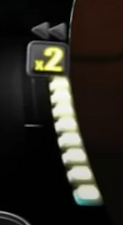
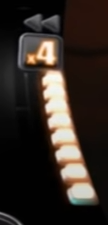
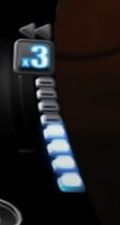

MULTIPLIERS
Another mechanic I noticed was score multipliers, when you hit a certain amount of notes in a row the multiplier increases and you get more points added to your score. This is a pretty standard mechanic in rhythm games and something I could translate over to my combat.

As my game does not use a score, I think I might translate this by a multiple doing more damage to the enemy. I felt while playing the game that it didn't seem to change much when the multiplier increased and didn't give much incentive to try and increase it. I think making the multiplier increase damage in my game gives more incentive to try and get it, compared to score in this game.
Another similar mechanic was an ability called "euphoria", it can be used after maintaining a high multiplier and automatically slides between songs for you. Compared to multiplier, this has more value as sliding between songs is probably the hardest part of this game. I think I will use something similar in my game, an ability that maybe helps the player with hitting notes, deals damage, or gives the player health. I think doing this would add more strategy and fun to my game and add to the game feel by rewarding the player for doing well.
CHOICE OF MUSIC
The song I played in my recording was a mix with Feel Good Inc. by Gorillaz and I Heard it Through the Grapevine by Marvin Gaye. Both of these songs have very catchy and memorable rhythms which I think is key when making songs for rhythm games. It is best when the song is easily memorable so the player can get used to how it sounds - making pressing the notes in time easier. I will take this into mind when making my own music an try to make the song catchy.
NOTE PLACEMENT
Another thing I noticed when playing was that there were moments where the notes were synced along the song really well, and made it very satisfying to play. Specifically this moment in the video, on the "oh oh" vocal you have to press 2 buttons at the same time which feels great and like you're actually playing the songs. Same with the scratching right afterwards, it feels like you're actually influencing the song. I think this is really good for game feel and something I want to replicate in my own game, making it feel responsive.
THE CONTOLLER
Obviously a big part of this game's appeal was its controller, it allows for motions that you cannot do with a controller or keyboard and makes this game unique from other rhythm games. And obviously, I cannot use any peripheral controller like this in my game, only the keyboard or mouse. Playing the game got me thinking about how I can make my game interesting while not having the controller, one of my ideas being using the mouse for a mechanic. I think to compensate I am just going to have to put in extra effort to make sure the game is still appealing with its simple controls.
CHANGING BACKGROUNDS
The last thing I noticed when playing was the backgrounds - can be seen in previous clips. They change based on what is happening in the song - going in reverse when the song goes backwards for example. I liked the way this looked and added more life to the game. I want to include a similar style in game, maybe with different colours and effects in the background that correspond with the music.
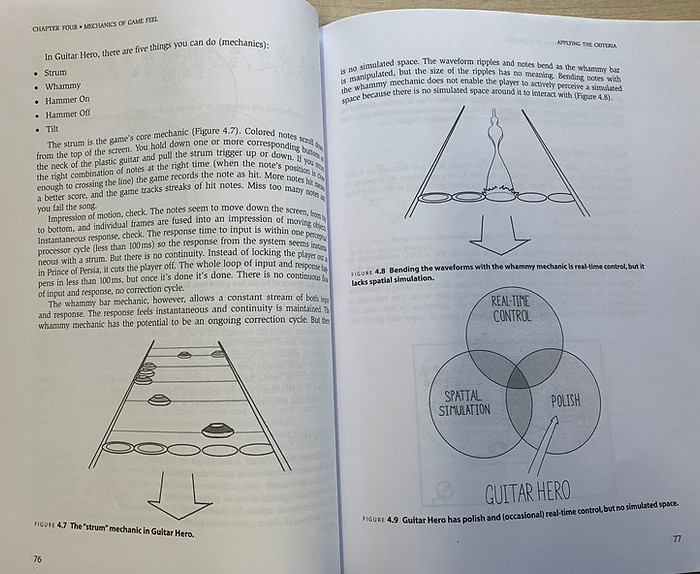
Lastly I found a section on Guitar Hero in Steve Swink's book Game Feel. While this is a different game it is essentially the same mechanic just with a different controller so is still relevant. It speaks about the good and bad aspects of Guitar Hero in terms of game feel. The good : an instantaneous response when pressing buttons, impression of motion in the notes moving down. The bad : no continuity, once the button is pressed it is over and does not flow. Lack of
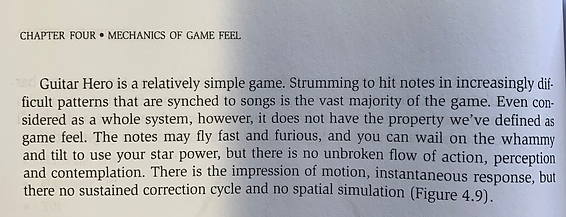
simulated space means that the player has no real input on what is happening and is just pressing buttons. Essentially, the game has polish but lacked a lot of important elements of game feel. I will take this into consideration when making my own game and try to rectify the problems suggested to make it the best possible experience. For
example, I will try and make it so the game feels responsive and so the player is controlling the flow of action, with animations and sounds that correspond with what is happening. I will also try to replicate the good parts mentioned in this review.
In conclusion, this research has been very helpful in solidifying how my idea will look and function, and is a good reference point when I am struggling with how my game should develop further.
FLOW THEORY
Flow theory is a game design theory focused on making players forget time when playing and balancing player skill and difficulty to make the game enjoyable. I wanted to look into this as it applies to pretty much to every game I could make and helps to make my game more enjoyable to an audience.


I found this article which spoke about the basics of flow theory. What I got from this is that the main parts of flow theory are :
-
Causing players to lose track of time
-
Balancing skill and difficulty
-
Making goals clear
-
Removing distractions/complications.
These are all important because if a game doesn't have good flow, the player will feel no incentive to play, or more importantly want to come back to, the game.
Next I watched this video about Flow Theory and took some notes about what it is and how I can achieve it in my game.
-
It is a psychological theory that creates engaging challenges for the player
-
A way to achieve flow is by presenting the player with a challenge, the player then achieving flow and then maintaining that flow.
-
If a game has good flow, each action flows from one to the next without the player having to think about what button to press next or where to look.
-
To have good flow a game has to scale the difficulty based on how skilled the player is. At the start of the game the player has no skills and needs to be taught what to do, but at the end of a game the player has mastery over the mechanics and needs to be presented a harder challenge.

-
The graph above shows the idea of 'flow channel' - keeping a balance between the games challenge and the players skill. Making the challenge too high while the players skill is low causes anxiety - the player gets frustrated that they cannot beat the challenge and the flow is broken. Making the challenge too low when the players skill is high causes boredom - the game is too easy and the player loses interest, losing the flow.
-
A way to balance skill and challenge is by introducing a mechanic or skill, then progressively using it in more difficult situations or adding new elements to it. An example would be a platformer, the player is introduced to the jump with simple challenges and then is faced with more difficult platforming sections or different types of jumps. This ensures that the player is not overwhelmed by these mechanics by teaching them how it works bit by bit.
The last thing I did for this research was look at this article which was similar to the video but spoke about a part of this theory called microflow and macroflow. Macroflow was just another word for the flow channel but microflow was new. It is basically a smaller version of flow, just focusing one short but intense moment. It is repeated multiple times during gameplay, the player given rewards after completing the challenge. An example of

this is the player engaging in an intense fight with an enemy for a short time and then given a reward for doing so, returning to calm afterwards. It keeps the player engaged and gives them incentive to keep playing.
Going forwards into development of my game, I will definitely keep this theory and its aspects in mind as feel like using them will make my game much more enjoyable and engaging for the player.
CONTEXT REVIEW REFLECTION
Today I did my context review, with the feedback below.

I think my review went really well as I got across everything that I had been doing and got very positive feedback. I learnt a lot from doing my research, like more skills in construct, more understanding of 2D top-down games such as mine, more understanding of music and also how effective pixel art should look. For example my research into rhythm games helped with how my own should look and function. In terms of the feedback, the only suggestion I got was to look more into the rhythm game community and see what they like and dislike about various rhythm games so I can take this into mind when making my own game. I may look into some Reddit communities or Metacritic reviews on various rhythm games.